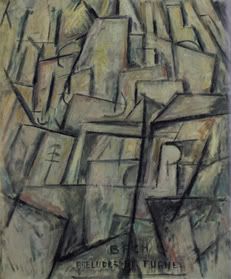
B. is for Bach—
and all his noble sons,
who wrote square music for nave
and for loft,
for arch and for aisle,
for all the lost, forsaken things
no other sound will save—
– Marsden Hartley
right: Musical Theme No. 2
(Bach Preludes et Fugues), 1912
Marsden Hartley is a name easily lost among the shuffle of American modernists. He belonged to the same illustrious circle as Georgia O’Keefe and Charles Demuth, but compromised his celebrity by unveiling a series of some fifty paintings whose seeming subject was the German military. On the eve of the Great War, the predilections of the “War Motif Series” and its homoerotic overtones were unsurprising cause for suspicion.
The most enterprising painter to emerge from Stieglitz’ stable at Gallery “291,” Hartley traveled to Paris in 1912 to keep abreast of the latest developments in modern painting. Music seemed to be on everyone’s mind. Picasso, for example, was incorporating the musical motifs of his native Spain into his cubist paintings and was soon to cultivate a friendship with Stravinsky. Kandinsky, whom Hartley followed to Berlin, likened the spiritual swirls of color on his musically-named canvases to Schoenberg’s treatment of line and motive.
Synthesizing the spiritual palette of Kandinsky with the intellectual prism of Picasso, Hartley developed a system of “cosmic cubism” with Bach as its presiding god. For Hartley, Bach was not just the father of music but the father of all abstract art, of “form in form.” The painting above is one of four which Hartley dedicated to the composer; the poem meditates on the divine geometry and consolation of Bach’s music to the gay expatriate, perhaps one of the many “lost forsaken things / no other sound will save.”
May 25th, 2008
Horowitz plays Nun komm der Heiden HeilandHorowitz plays Nun komm der Heiden HeilandI’ve been at work on the Bach-Busoni organ choral preludes, two of which I performed at a student recital earlier this year. These ten pieces, Bach originally composed for choir and orchestra, but bless him for transcribing them for organ, and Busoni for transcribing the transcription for piano. The recordings by Vladimir Horowitz and by Murray Perahia are nothing short of inspiring.
The genre of the piano transcription has a fascinating history. Its heyday was in the nineteenth century when the domestic demand for music was at an all time high, and composers would repackage box-office hits as solo and four-hand music to be played in the comfort of one’s own home. At the same concert music was being commodified for the domestic market, composers were transforming domestic music for the concert market. The career of the pianist/composer Franz Liszt, famous for his adaptations of orchestral works (e.g. Beethoven’s Symphonies) and transfigurations of salon repertoire (e.g. Schubert’s Erlkönig), illustrate both trends.
Liszt’s successor as a seasoned transcriber was Ferrucio Busoni, who defended the mantle of nonoriginality in a concert note later reprinted in the second edition of his polemical essay A Sketch for a New Aesthetic of Music (1906):
To redeem once and for all the artistic value of transcription [Bearbeitung] in the eyes of the public, it is only necessary to cite the example of Johann Sebastian Bach, who as an organist, was one of the most prolific adapters of his own and others’ music. From him, I learned that a good, great, and universal music is still music, regardless of the means through which it resounds…and that various means have their own individual language in which they express the same content in an ever new light” [translation mine]
All transformations, in other words, illuminate the essence of the original. Be that as it may, Liszt transcriptions—even those of Bach—have always struck me as exercises in musical machismo. Busoni’s, however, are acts of homage. Like Liszt, Busoni prepared “free arrangements” [Freie Bearbeitungen] of Bach like the out-of-this-world Fantasia Contrappuntistica (a modernist gloss on the unfinished contrapunctus of Bach’s Art of Fugue) and stricter transcriptions like the Chaconne in D (a favorite of gym virtuosos who have no business playing Bach). More reverent were Busoni’s transcriptions of the ten Orgel-Choralvorspiele. Contrapuntal works present the greatest difficulties to the transcriber given the objective of replicating the intricate helix of crossing voices. With the organ preludes, Busoni’s challenge was to integrate the chorale tune (cantus firmus)—which in the organ transcription was in the foot pedals—into an arrangement for two hands. Thus one finds the choral tune sounded by the treble pinky, or by the bass octaves, or most frustrating, shared by the thumbs.
With the possible exception of “Nun freut euch” (No. 4), the ten organ choral preludes are not perilous pieces. But they do compel the pianist to think like the orchestra and choir for which they were originally composed. This is their distinct challenge. How does one create the sense and continuity of multiple instruments with just two hands and a single instrument? Horowitz’s rendition of “Nun komm der Heiden Heiland” (No. 3) is revealing in this regard.
[kml_flashembed movie=" " width="425" height="344" wmode="transparent" /]
" width="425" height="344" wmode="transparent" /]
Horowitz generates such range of color by his diversification of attack. I’ve noticed, for example, how within the same hand, he approaches some keys with curved fingers and others with flat fingers to achieve subtle nuances in timbre between adjacent voices, and in volume between the cantus firmus and the surrounding counterpoint.
My goal this summer is to learn all ten transcriptions and perform them in concert sometime next year. Maybe not up to the level of Horowitz (who only recorded two), but one can always pick up a few things from so consummate a musician.
May 24th, 2008

 " width="425" height="344" wmode="transparent" /]
" width="425" height="344" wmode="transparent" /]